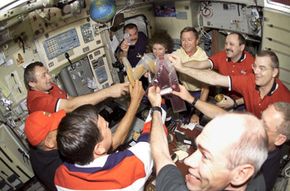Space Food on Mission Menus
Today astronauts have dozens of different foods to choose from. They also play a big part in the selection process. About five months before a mission launches, crewmembers get to visit the Space Food Systems Laboratory at the Johnson Space Center in Houston, Texas. At the lab, astronauts act as food critics. They sample 20 to 30 items and rank them on a scale of 1 to 9 in appearance, color, smell, taste and texture. Any food that scores a 6 or higher can make it onto the menu.
Astronauts don't get the final say, however. A dietitian checks the menu to make sure that it contains enough nutrients. Astronauts need 100 percent of their daily requirements of vitamins and minerals.
Advertisement
But because the environment in space is different than that of Earth, they need to adjust their intake of certain nutrients. For example, astronauts need less iron than they do on Earth. Iron is mainly used to make new red blood cells but astronauts have fewer red blood cells in space. If they eat too much iron, it can build up and cause health problems. Astronauts also need extra calcium and vitamin D, because bones don't get the exercise they need to stay strong in the weightless environment.
But how does food stay fresh in space? And where do necessities like water come from? Learn how food gets into space in the next section.
